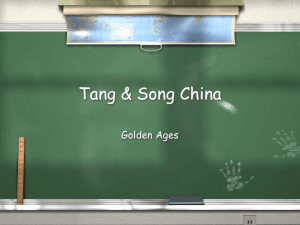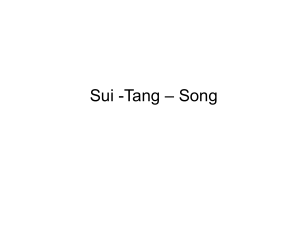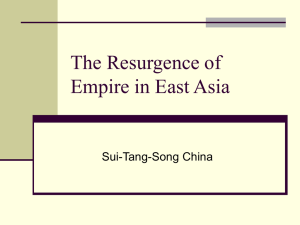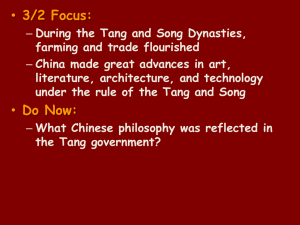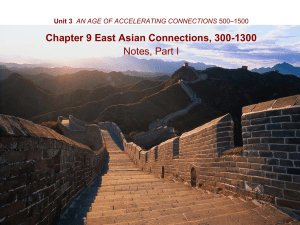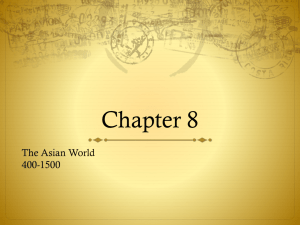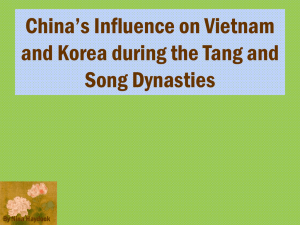Lecture Outline 17
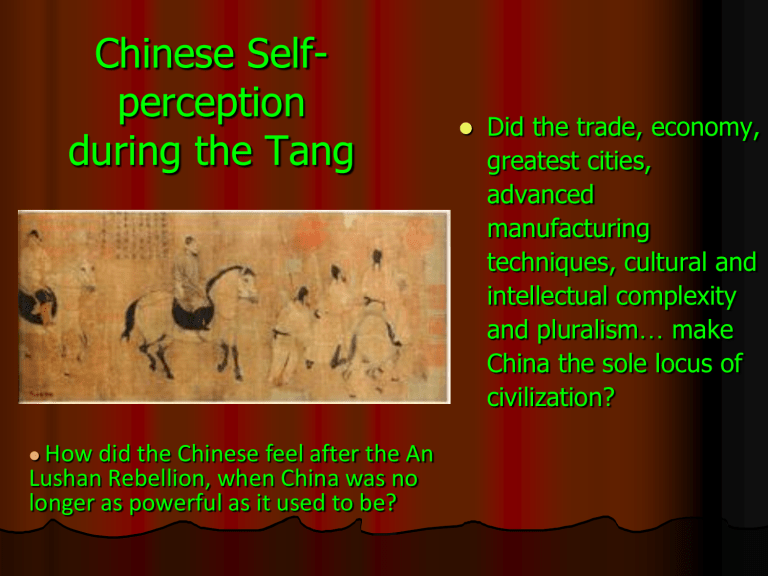
Chinese Selfperception during the Tang
How did the Chinese feel after the An
Lushan Rebellion, when China was no longer as powerful as it used to be?
Did the trade, economy, greatest cities, advanced manufacturing techniques, cultural and intellectual complexity and pluralism … make
China the sole locus of civilization?
Intellectuals ’ Pleas for Reforms
Rethinking the primacy and centrality of the emperor
Should the imperial institution, ritual, and power be the only concerns?
What made a government effective and the state prosper and stable?
Advocates of reforms
Du You (732-812)
Han Yu (768-824)
Han Yu
Two Views on Reforms
Du You ’ s view: economic and progressive
Economic policy should take people ’ s livelihood into consideration
Government should learn from the past and change with the times; not pattern itself on ancient institutions and feudal systems
Han Yu ’ s view: cultural
Reaffirmation of Confucian classics and literature, including the classical style of writing
Rejuvenation of Confucianism would bolster the state
Chinese civilization began with the sages, who saved people from perils, showed them how to secure food … .Leaders should grasp the “ Way of the Sages ”
Han Yu Shrine, Changli County,
Hobei Province, 1928
Daoist Temple, Geling, Hangzhou
The turning point: Post-
Rebellion late Tang
Tang emperors lost their political and economic controls; powerful autonomous regional governments rose
Agricultural and technological advances facilitated economic growth in the south
Increasing migration made the south, particularly the
Yangzi River valley, develop further
Rebellions and turmoil weakened Chang ’ an as a cosmopolitan city
The Fall of the Tang/Chang’an
Despite the temporary “restoration” during
Xianzong’s reign (r. 805-820), the Tang began to fall apart again.
Autonomous military governors, eunuchs, large scale rebellions, banditry in countryside… further weakened the Tang.
Anti-Buddhist and anti-foreign sentiment heated up because foreigners and monks drained gov’t tax revenue.
Incompetent emperors lost people’s trust
The natural calamity signaled that the last few emperors of the T’ang had lost the “Mandate of Heaven” ( 天命 tiān mìng )
Chang’an was ransacked and burnt several times, as a result of peasant’s rebellion, warlord’s and foreign armies’ attacks.
Poets wrote poems when witnessing the demolition of Chang’an
Lament of the
Lday
Qin by Wei
Zhuang
…
In house after house blood flows like boiling fountains;
In place after place victims scream: their screams shake the earth.
Dancers and singing girls all have disappeared,
Babies and young girls are abandoned alive…
…
My neighbor in the west had a daughter, lovely as a goddess;
Her lustrous eyes flashed from side to side cutting waters like an inch of sword blade.
Her toilet completed, all she did was gaze at the reflection of spring in her mirror,
Lament of the
Lday
Qin
So young she didn’t know what happened outside her doors.
Some thug leaps up her golden staircase,
Rips the dress to bare half her shoulder, about to shame her,
But dragged by the clothes she refuses to go through the vermilion gate,
So with rouge powder and perfumed cream on her face
she’s stabbed down till she’s dead.
Lament of the
Lday Qin
…
Chang’an lies in silence: what’s there now?
In ruined markets and desolate streets, ears of wheat sprout…
The Hanyuan Hall is the haunt of foxes and hares…
Along the Avenue of Heaven one walks on the bones of high officials.
….
The fall of the Tang and the destruction of
Chang’an anticipated the selection of a new capital site near the major section of the Grand Canal
The Five Dynasties succeeded the Tang with the Later Liang founded by the military governor/warlord Zhu Wen, who made his military stronghold, Kaifeng, the capital of his dynasty.
China in the
Northern Song and Its New
Neighbors
China in the Southern Song and Its New Neighbors
The Khitan Empire (The Great Liao Dynasty)
– Lived in today’s southeastern Inner Mongolia
– Adopted traditional nomadic life style but allowed the Han Chinese to live Chinese style of life
– Adopted Chinese imperial system
– Called itself the Liao Dynasty
– Ruled by the Yelü clan in “dual administrative system” or “dual system of government”
Emperors and nobles continued their nomadic practice
Created its own ideographic script based on Chinese characters
Became powerful during China’s Five
Dynasties period
– Occupied the northeastern Ordos region, where the Tuyuhun and Tangut tribes had settled
– Conquered the wealthy Bohai kingdoms in eastern Manchuria
– Forced the Later Jin Dynasty to cede sixteen bordering prefectures in present Beijing, Hebei, and Shanxi —including the prefectures of
Youzhou (Beijing) and Yunzhou (Datong) —to
Liao
– invaded the Later Jin capital Kaifeng, pillaged the palace and the residences, and took the emperor prisoner.
– Song needed to negotiate peace with the Khitan by paying annual subsidies in silk and silver
The Tangut (Xi Xia) Kingdom
– Linguistically related to the Tibetans
– Settled in Xia prefecture in Tang times and adopted the Tang dynastic family name Li
– Helped the struggling Tang dynasty in the 870s and 880s, especially against Huang Chao
(Rebellion).
– Song emperors recognized its autonomy
– Internal political dispute over its relationship with the Song led to tribal unrest that provoked the Song force along the border
Dispute between two camps led by Li Jipeng and Li
Jiqian separately
– Began in 982 the Sino-Tangut war that lasted until 1004
– Amid its vacillating war-and-peace relations or dual relations with the Liao and the Song, it expanded its territory to the west and north, into the Gansu corridor and neighboring Inner
Mongolia.
– Enjoyed an autonomous status and political independence as Tang’s vessel state.
– Song needed to pay annual subsidies in silk and silver
The Song Dynasty
Established in 906 after the
53 years of division during which China was ruled by warlords — the period of “ Five
Dynasties and Ten Kingdoms ”
Five dynasties were in the north; nine of ten kingdoms were in the south
All except one of the rulers of the Five Dynasties had their capital set up in Kaifeng
Emperor Taizu, Zhao
Kuangyin, (r. 960-976)
The founder of the Song built his capital in Kaifeng, where he began a new dynasty — the Song ruled by the Zhao family.
Kaifeng was referred to as
Eastern Capital ( 東京 dōng jīng ) or Bian jing (汴京 biàn jīng)
Luoyang was now Western
Capital ( 西京 xī jīng)
A new ruling philosophy that stressed the priority of civil principle ( 文 wén ) over the military principle ( 武 wŭ) also started.
A new dynasty that might come close to what we call “Confucian state” emerged
Emperors ruled and performed rituals according
Confucian rules, but remained devoted to
Daoism and Buddhism
The first Song emperor Taizu began ruling by the civil principle, which was followed by his successors Taizong, Zhenzong, ….
Ruling by the civil principle became the creed of the Song dynasty
Song Culture:
Choice between
Wen
and
Wu
Early Song policy:
– Elevating the civil principle ( Wen) , downplaying the military principle ( Wu )
– Strengthening the trunk (center) and weakening the branches (regional governments)
Taizu is known for “dissolving military power over a cup of wine” when holding a drinking party with his senior commanders
Powers were concentrated in the hands of civil bureaucracy, whereas military officials were kept in check
Powerful generals and strong military men were forced to retire
Emperors had members of imperial family marry to sons and daughters of military officials’ families
Despite the wen policy, Taizu still planned to unify
China by using military force to annex southern kingdoms
– Unable to realize his plan because of his sudden death
– People speculated that he was murdered by his brother in a plot known as “the sound of the axe in the shadow of the flickering candle”
– The brother succeeded him, fulfilled his promise and reunified China. He was known as Taizong.
The image of Taizu, who laid down this policy of wen
– A protector of the people
– A ruler who aspired to live by the humanitarian and benevolent standards of Confucian teachings
– A modest man who detested luxury and splendid residences, wanting to live a life of frugality
– Concerned himself with commoners and their economic well-being



